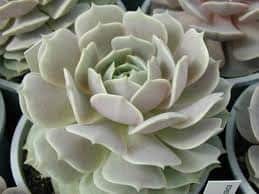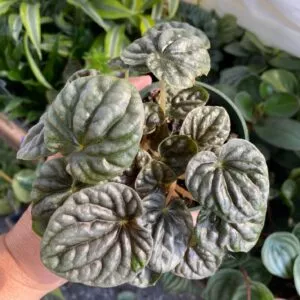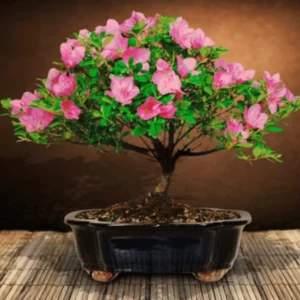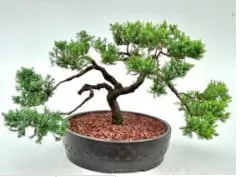No products in the cart.
Table of Contents
This tropical plant would undoubtedly hold your gaze as you marvel upon its bright-green broad foliage and delicately drooping flowers in soft pink shades.
The evergreen shrub typically thrives on trees found in tropical forests, particularly in southeast Asia. The overall plant structure resembles the shape of a chandelier making them not only an eye-catching specimen but a unique ornament to ever grace your garden!
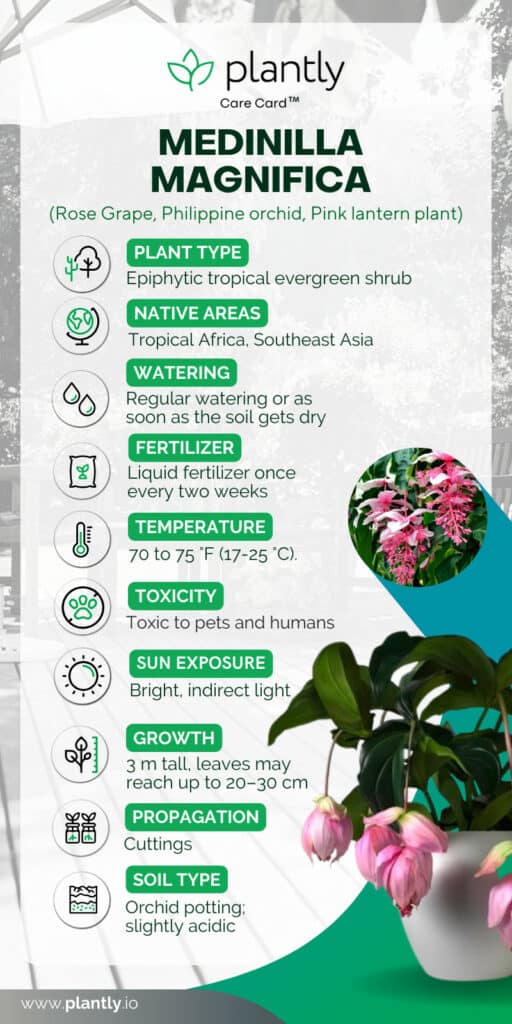
Medinilla Magnifica Plant Care Basics
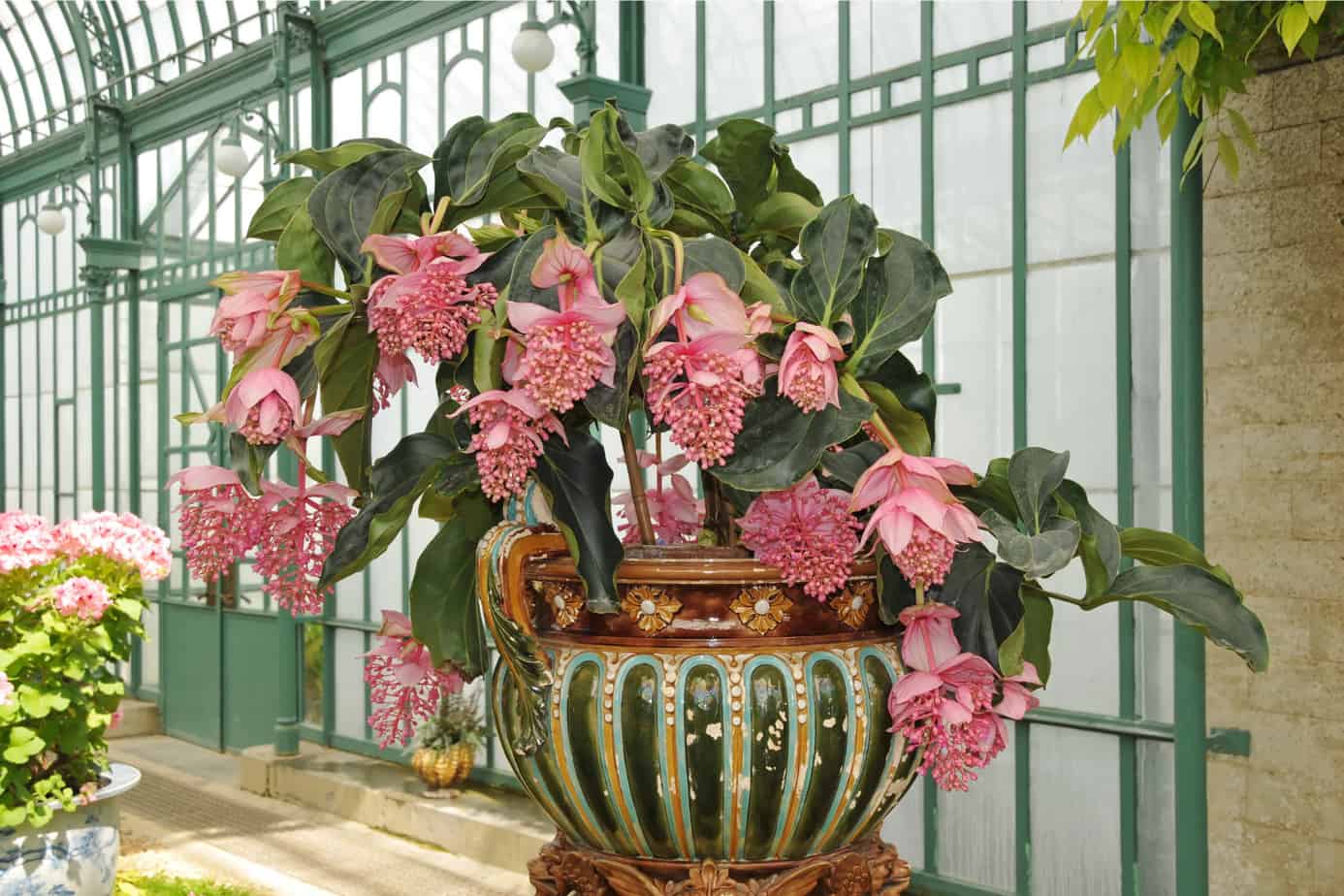
Medinilla is said to have been grown for hundreds of years. This exotic houseplant is highly coveted by the rich and members of the upper class in Belgium.
If you, too, wish to marvel at this tropical beauty in the comfort of your home, Plantly certainly has your back!
Soil Requirement
Any well-draining soil potting mix works just fine. But to provide that ideal growing condition for your Medinillas, soil mixed with peat moss will do the trick. The addition of damp sphagnum peat moss mimics the slightly acidic soil conditions that they are used to in a tropical climate.
The Best Lighting Condition
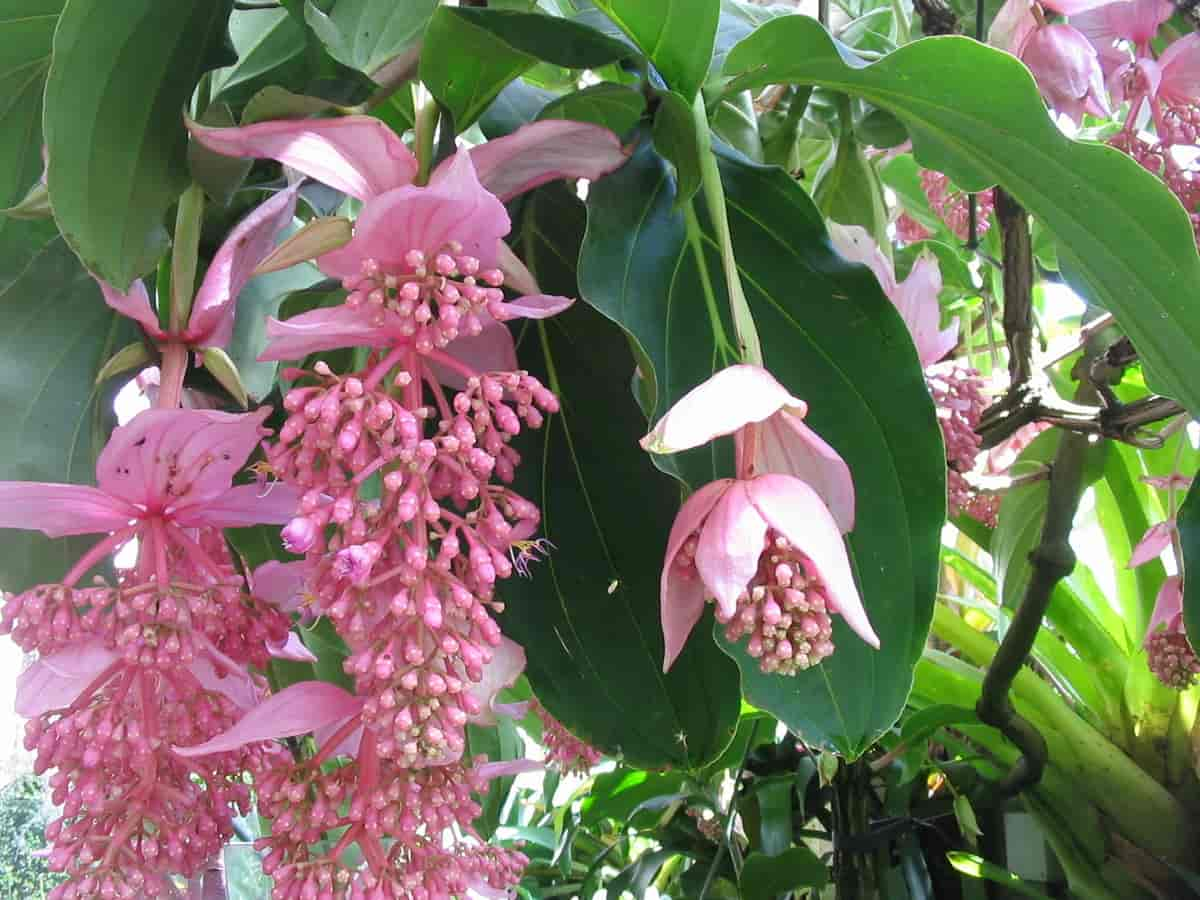
In their native environment, most Medinillas are typically nestled in the lower branches of tall large trees, hence they are most suitable to be grown under shaded conditions where they receive just enough light.
Too much direct sunlight can damage the foliage and leave you with scorched leaves. If you wish to have them as indoor plants, create that condition even in a bright room with an adequate interception.
Watering Needs of Medinillas
During the growing season, watering the compost well enough provides an ideal environment for Medinillas to proliferate. Allow the topsoil of a least 2 cm to dry out first before the next watering cycle.
Keep a record of your watering cycle and be sure to supply them with just enough, particularly after the rest period to stop the plant from dehydrating. Water moderately in early-mid Spring especially when the flower stalks begin to appear.
Temperature and Humidity

Medinilla plants are most suitable for a warm and humid environment. Observe a temperature of 64-77ºF (18-25ºC) throughout the year. It’s important to note the temperature threshold for the winter period which must not go lower than 15ºC (59ºF).
You can easily maintain high humidity with a cool-mist room humidifier. Added humidity may also help to prevent an infestation of spider mites that are easily attracted to dry conditions.
The Need for a Well-balanced Fertilizer
Known as a light feeder plant, Medinillas may only need fertilizer at weekly intervals. During the flowering season, they may be fed with the usual orchid fertilizer with half the recommended dose. It’s important to avoid overfeeding the plant at this point, as too much nitrogen may induce more foliage development rather than flowers.
In the winter months, and after the flowering period, the weekly interval may be reduced to once every 15 days. A liquid compost may do trick in keeping the soil fully packed with nutrients while also being mildly acidic.
How to Propagate?
While seeds can also be used in propagating this tropical beauty, the use of cuttings as planting materials may be the best option. Do this by taking a cutting with at least two leaves. It is imperative to remove two-thirds of each leaf to maximize the distribution and use of assimilates on developing organs such as roots.
Place them in a mix of damp sphagnum moss. You may also take advantage of the use of a rooting hormone so the cuttings may develop roots faster.
In stock In stock In stock Only 1 left in stock
$7.99 – $9.99
Sold By:
Succulent Oasis
Echeveria ‘Lola’ Succulent | Beautiful Rosette in Shades of Pale Green and Lavender
Rated 4.84 out of 5 based on 352 customer ratings05
Sold By:
Succulent Oasis
$12.00
Sold By:
Smoot's Farm
Peperomia Caperata Radiator Plant Emerald Green Ripple 4 Inch Pot Live Plant
Rated 4.89 out of 5 based on 27 customer ratings00
Sold By:
Smoot's Farm
Free Shipping
$193.17
Sold By:
BONSAI WORLD LLC
Pink flowering Medium azalea bonsai tree
Sold By:
BONSAI WORLD LLC
Free Shipping
$750.09
Sold By:
BONSAI WORLD LLC
Juniper Bonsai Tree – Trained (juniper procumbens nana)
Sold By:
BONSAI WORLD LLC
Growth Zone of Medinilla Plants
Ideally, most Medinilla plants are suited to USDA hardiness zones 10 and 11 – where they may be grown as outdoor plants to brighten up patios and amplify the vibe in any tropical gardens.
However, during the winter months, they must be brought indoors to protect them from frost damage.
Potting and Pruning Techniques
Interestingly, Medinilla magnifica can reach 5-8 feet tall in its native habitat. Yet as a houseplant, being suppressed by the place they grow in, they may only reach around 3 feet tall.
After flowering, it’s important to prune plants by cutting back unwanted branches – almost reaching the base. Pruning is an effective way to rehabilitate the plant and keep them healthy. This later promotes new growth and more flowering as the new season arises.
You may re-pot the plant in the winter or spring. Directly place them on a pot with sizes ranging from 18 cm to 25 cm, carefully tending to the roots.
A typical orchid pot that usually has air ventilation holes is also suitable to be used. They allow proper air circulation around the roots which in turn prevents the occurrence of root diseases.
Medinilla Species and Other Similar Plants
Through the years, Magnifica medinilla gave rise to many cultivars which are commonly labeled according to the colors of their blooms.
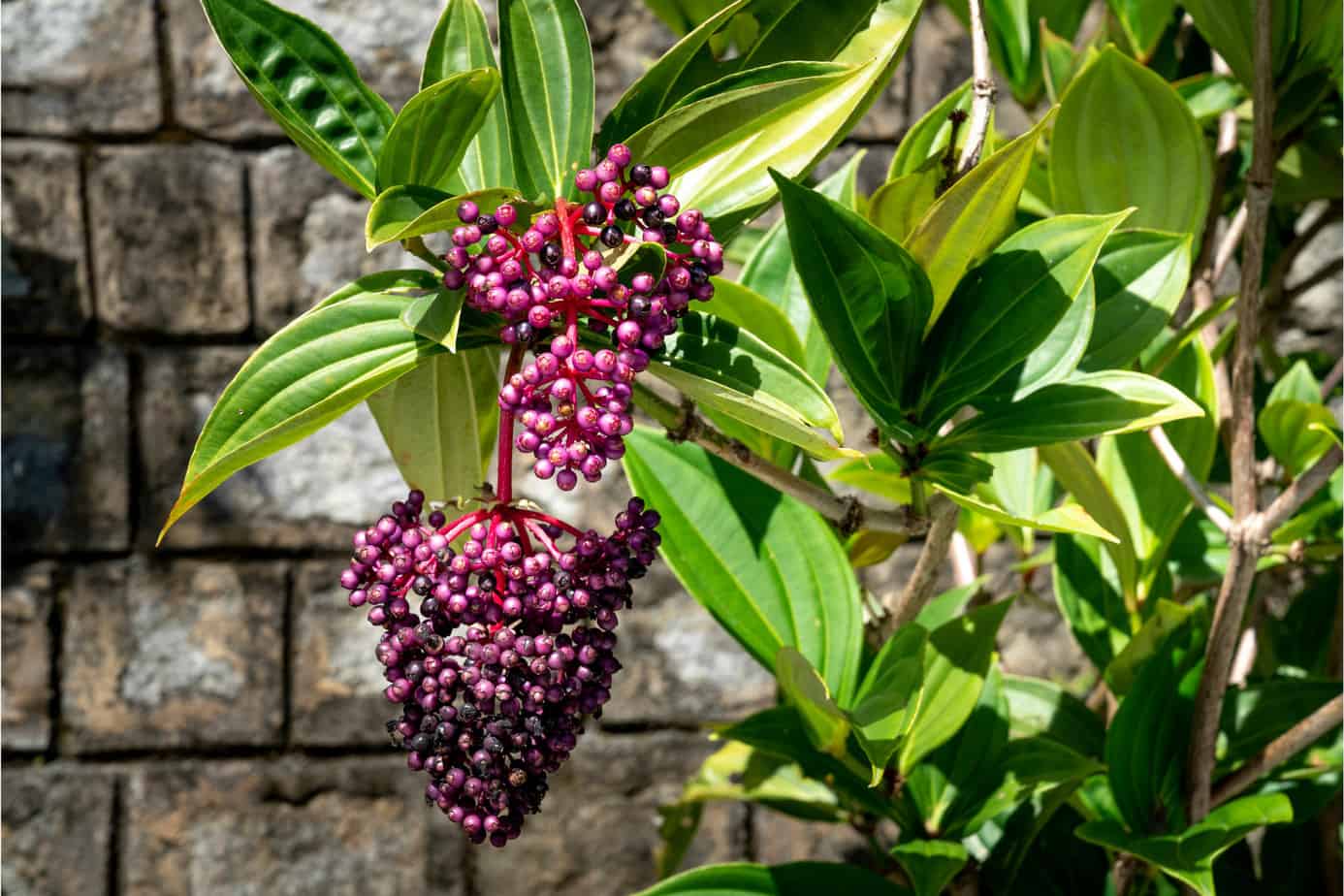
Medinilla cummingii
Medinilla cummingii is native to the mossy forest in the Philippines and is often referred to as a chandelier tree. The plant features dense flowering panicles that produce purple to black fruits. This small shrub can only grow up to 1–2 m in height.
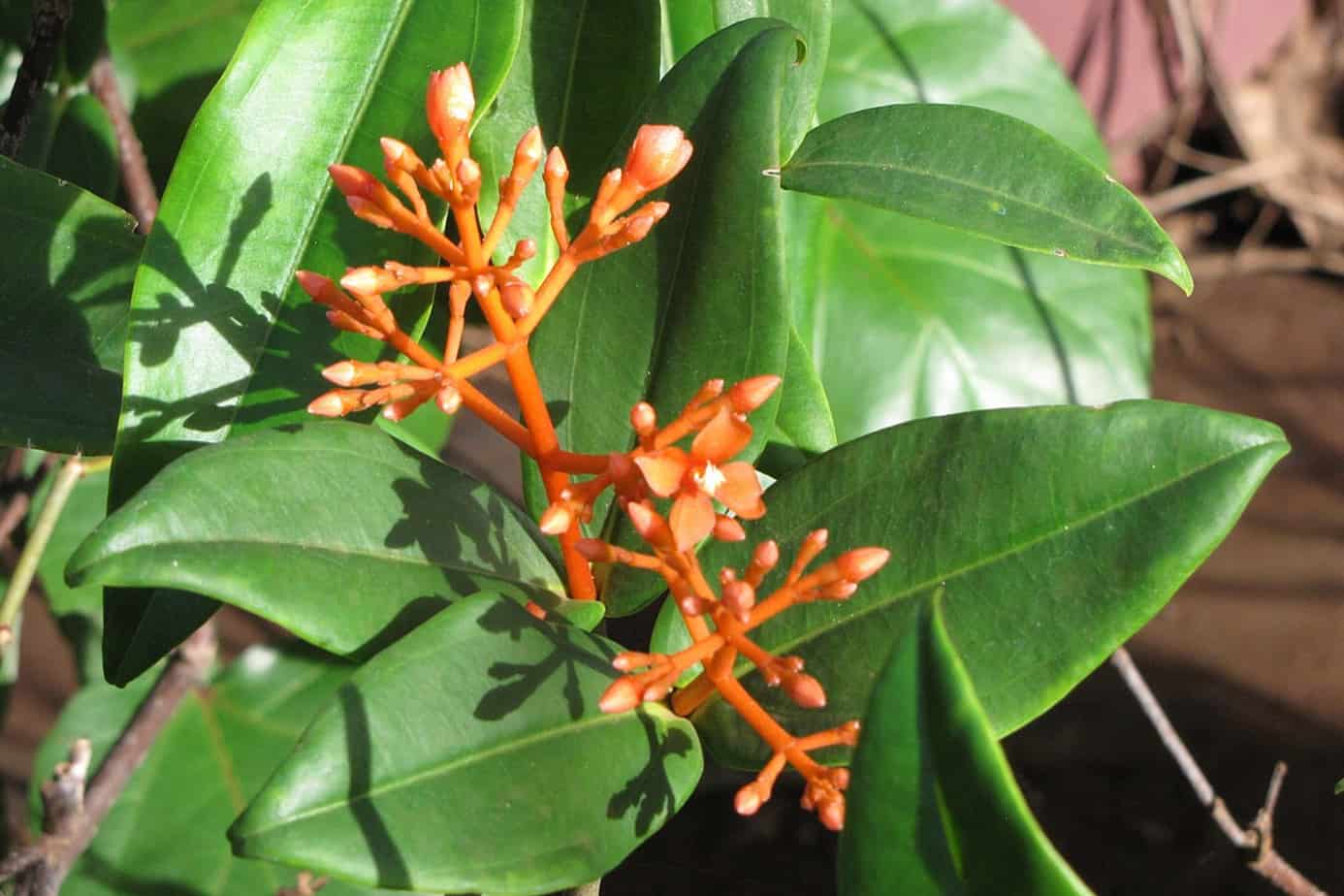
Medinilla scortechinii
Also known as Orange Coral Medinilla, this rare tropical shrub will surely turn heads as they flaunt their dark green, leathery broad leaves, with unusual-looking flowers that have bright orange-pink stalks and panicles.

Pink Medinilla
This cultivar is characterized by large bracts that bear clusters of pink flowers. The Pink Medinilla can grow up to 6 feet tall, hence perfect for large patio containers.
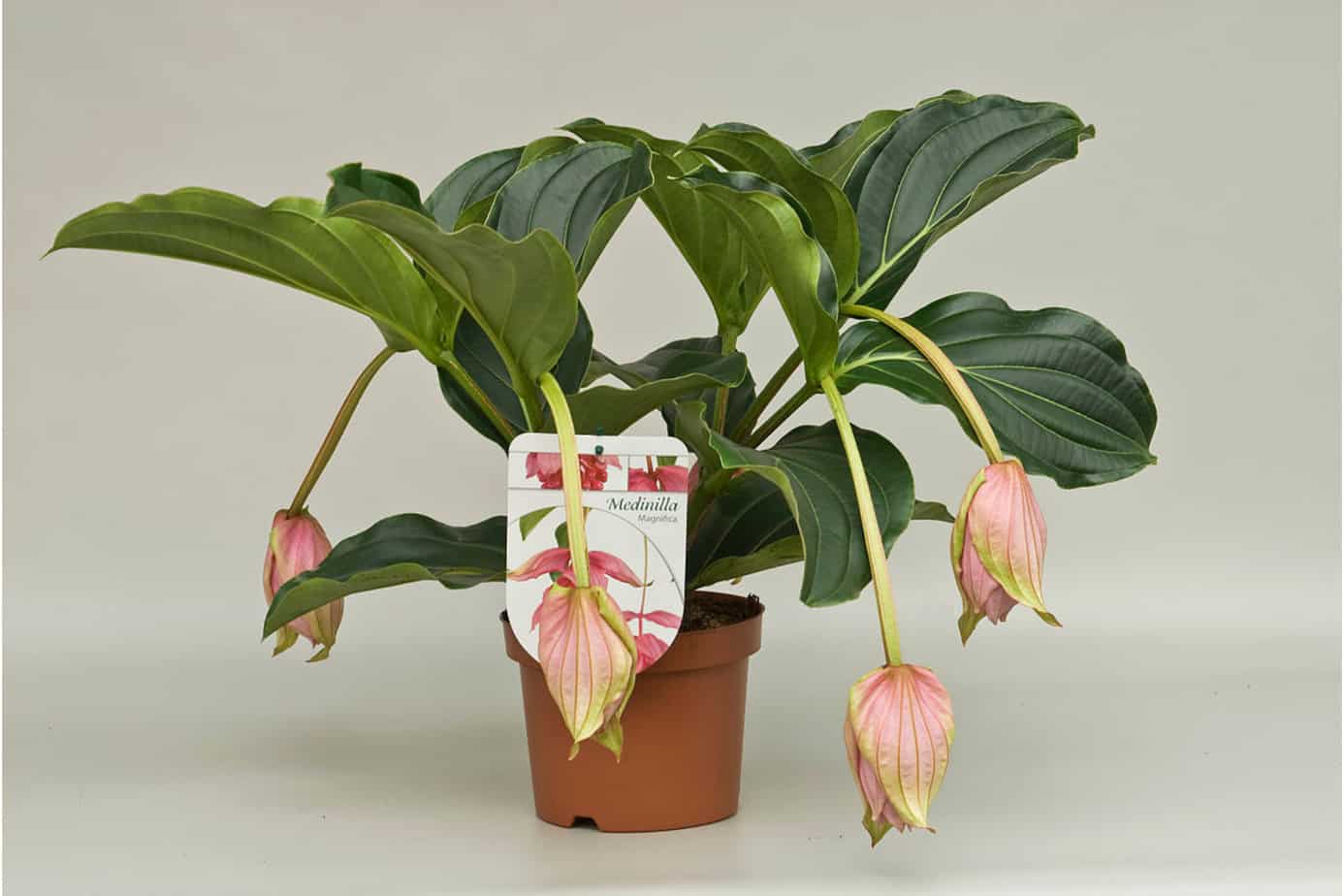
Medinilla Dolce Vita
Medinilla Dolce Vita is known for its upright, delicately curved foliages, and hanging soft pink blooms. This stunning specimen also prefers humid environments and a temperature range of 17 to 25 ° C. They can certainly liven up any dull spot in your home.
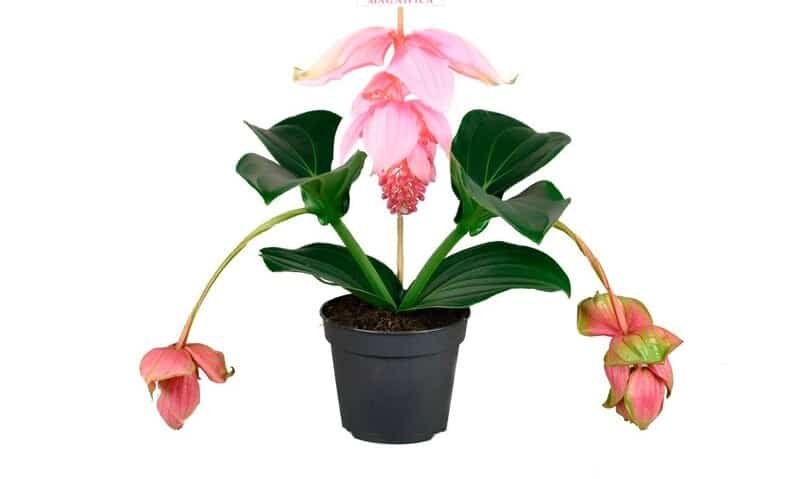
Medinilla piccolini
Big lustrous leaves and an impressive cluster of flowers are what make this variety an ideal plant to fill in spaces. If you wish to have them settle indoors, be sure to increase humidity levels by regularly misting the plant and avoiding direct sun exposure.
In stock In stock In stock Only 1 left in stock
$7.99 – $9.99
Sold By:
Succulent Oasis
Echeveria ‘Lola’ Succulent | Beautiful Rosette in Shades of Pale Green and Lavender
Rated 4.84 out of 5 based on 352 customer ratings05
Sold By:
Succulent Oasis
$12.00
Sold By:
Smoot's Farm
Peperomia Caperata Radiator Plant Emerald Green Ripple 4 Inch Pot Live Plant
Rated 4.89 out of 5 based on 27 customer ratings00
Sold By:
Smoot's Farm
Free Shipping
$193.17
Sold By:
BONSAI WORLD LLC
Pink flowering Medium azalea bonsai tree
Sold By:
BONSAI WORLD LLC
Free Shipping
$750.09
Sold By:
BONSAI WORLD LLC
Juniper Bonsai Tree – Trained (juniper procumbens nana)
Sold By:
BONSAI WORLD LLC
Medinilla Magnifica Plant Diseases & Pests
While the Medinilla magnifica appreciates moderate moisture, they are vulnerable to root rot and are not exempted from symptoms such as yellowing and premature leaf drop. Hence, it’s important to keep track of how much water is given and monitor the topsoil for dryness before watering the plant.
Moreover, mealybugs can infest your Medinilla plants if not addressed early. They weaken the plants by sucking juices from the foliage and may eventually result in wilting, curling, and necrotic plant tissues. Yikes!
Control infestation by dipping cotton balls and swabs in alcohol and removing all mealybugs that you can find on the surface.
Spider mites, on the other hand, are attracted to dry conditions, so keep them at bay by regularly misting the plant.
Frequently Asked Questions
Find a spot with bright indirect sunlight, particularly in between March and November. In the winter months, try to keep them in a place that receives adequate bright light while making sure that they are watered once every 5-7 days.
Ideally, a winter temperature of 16 – 18 °C for two months will induce the formation of new flower buds.
Medinilla magnifica has a flowering period of 3 months, but other varieties can flower for up to 6 months. Provided an optimal growing condition, expect your Medinilla to be covered with drooping clusters of delicate pink flowers, particularly in the late spring to early summer.
If the surrounding saturation is too low or the ambient temperature is too high, you may notice that the young leaves turn brown and begin to curl over. When this happens, don’t panic and immediately place your plant in a cooler and humid environment.
Also, avoid overwatering as this may also damage your Medinilla in the long run. Use another container with a few inches of water and let your pot sit there for 10 minutes. Allow the plant to drain for at least 1 minute. Make sure that the soil fully dries out before observing the next watering cycle.
Medinilla plants are a must-have whether you are in for that tropical vibe or you simply want to indulge in exotic specimens for your garden. So for more options and care tips, visit Plantly today!
Whether you want to buy, sell or simply reach out to other plant enthusiasts, Plantly is the right place to be!
-
$7.99 – $9.99Sold By: Succulent Oasis
In stock
Echeveria ‘Lola’ Succulent | Beautiful Rosette in Shades of Pale Green and Lavender
Rated 4.84 out of 5 based on 352 customer ratings05Sold By: Succulent Oasis -
$12.00Sold By: Smoot's Farm
In stock
Peperomia Caperata Radiator Plant Emerald Green Ripple 4 Inch Pot Live Plant
Rated 4.89 out of 5 based on 27 customer ratings00Sold By: Smoot's Farm -
Free Shipping$193.17Sold By: BONSAI WORLD LLC
In stock
Pink flowering Medium azalea bonsai tree
Sold By: BONSAI WORLD LLC -
Free Shipping$750.09Sold By: BONSAI WORLD LLC
Only 1 left in stock
Juniper Bonsai Tree – Trained (juniper procumbens nana)
Sold By: BONSAI WORLD LLC
